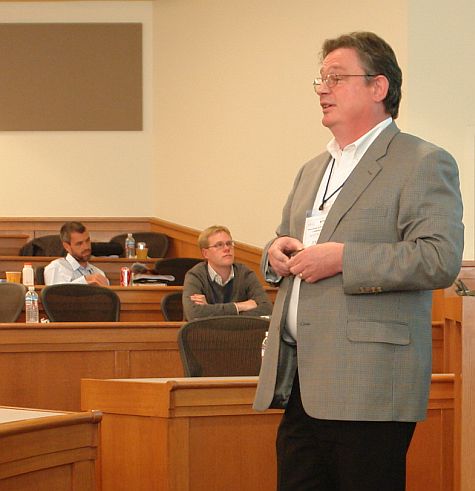This digest was created in real-time during the meeting, based on the speaker's presentation(s) and comments from the audience. The content should not be viewed as an official transcript of the meeting, but only as an interpretation by a single individual. Lapses, grammatical errors, and typing mistakes may not have been corrected. Questions about content should be directed to the originator. The digest has been made available for purposes of scholarship, posted on the Coevolving Innovations web site by David Ing.
Jim Spohrer, IBM Research

What we're thinking about service science these days
Service Innovation
- High Talent
- High Tech
- 2 people at Wikipedia enable 36,000 contibutors
- eBay, 13000 employees, 724,000 people have primary or secondary source of income from eBay
- Lots of platforms, like Second Life
High talent and high tech miss understanding customer intimacy and partner value networks (shared information and trust)
- Credit cards are a great service innovation, lots of people had to change behaviours
Bigger: Regulatory, Institutional and Social Context changes
- Think of a world without mass education
Why does IBM care?
- Look at profit margins in the two service businesses (29% to 23%), compared to software (83%)
- Scaling problem
We need some more shared vocabulary
- Service systems ... value propositions
- Service systems are designed
- Service systems evolve, they're complex systems
- Service systems have scale-emergent properties
Purpose of service systems ais value co-creation
- Prisoner's dilemma, we'd like win-win
- Has been a lot of different names: North economic institutions, Barnard's cooperation systems; Trist socio-technical systems; Englebart augmentation systems; Normann's value creation systems
- Value is in the eye of the beholder; trust matters, transaction costs matter
There's a lot of relationships (Gadrey, 2002)
Working on: how to invest to get systematic improvement in services?
- Think of benefits of Moore's law, which is an investment model
- What if we could create a Moore's law of innovation systems
Barnard, 1930s: Cooperative Systems, hard to read, but good
Richard Normann
Universities, hospitals, call centres, data centres, cities, nations
Trying to understand service systems:
- Design
- Improvements
- Scaling
- Profits scales up in information rapidly, but it's slow in labour
IBM Service Research Agenda
Study: Designing IT-enabled B2B services
Service Research and Innovation Initiative, May 30 in Santa Clara
- IBM and Oracle
Michigan Tech got NSF Funding to help develop new undergrad curriculum
[Questions]
Service systems as a way to start, because if you leave integration to the end, it's hard
Role of research in services?
- IBM invests $150M per year in services research, which is 1/6 of IBM after 4 years
- Lots of low-hanging fruit
- Practitioners are gravitating to this profession
Biggest challenge
- Trust
- People don't have the knowledge and experience to do the right thing
Moving ahead the research agenda on services?
- If you don't have business impact, it doesn't matter
- Still publishing in too many different journals, no sense of community
Service systems, moves us away from centering on firms. But when you get to systems, how to delimit.
- There are many types of service systems
- Paul Seaburg, the companion of strangers

This work is licensed under a Creative Commons Attribution-NonCommercial-ShareAlike 4.0 International License